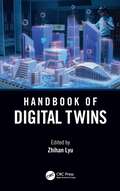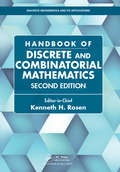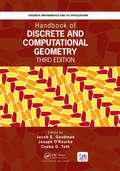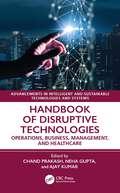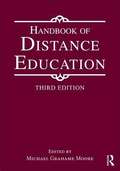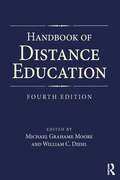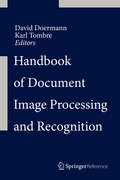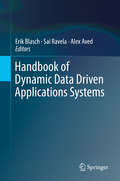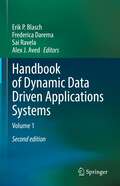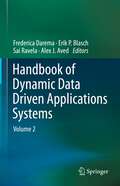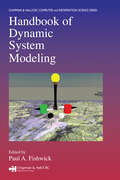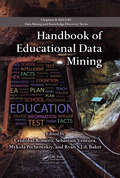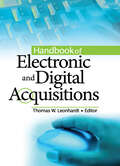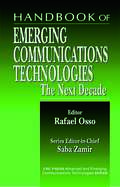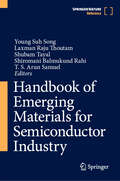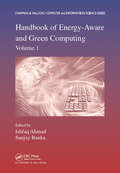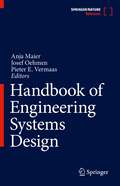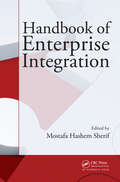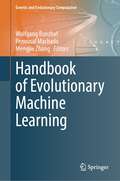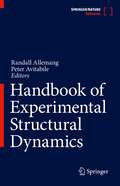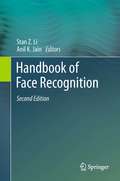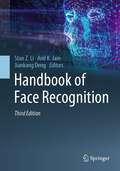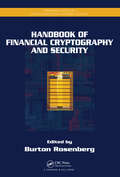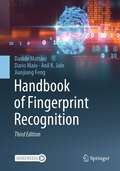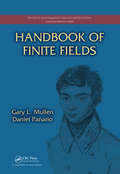- Table View
- List View
Handbook of Digital Twins
by Zhihan LyuOver the last two decades, Digital Twins (DTs) have become the intelligent representation of future development in industrial production and daily life. Consisting of over 50 chapters by more than 100 contributors, this comprehensive handbook explains the concept, architecture, design specification and application scenarios of DTs.As a virtual model of a process, product or service to pair the virtual and physical worlds, DTs allow data analysis and system monitoring by using simulations. The fast-growing technology has been widely studied and developed in recent years. Featured with centralization, integrity and dynamics, it is cost-effective to drive innovation and performance. Many fields saw the adaptation and implementation across industrial production, healthcare, smart city, transportation and logistics. World-famous enterprises such as Siemens, Tesla, ANSYS and General Electric have built smart factories and pioneered digital production, heading towards Industry 4.0.This book aims to provide an in-depth understanding and reference of DTs to technical personnel in the field, students and scholars of related majors, and general readers interested in intelligent industrial manufacturing.
Handbook of Discrete and Combinatorial Mathematics (Discrete Mathematics and Its Applications)
by Kenneth H. RosenHandbook of Discrete and Combinatorial Mathematics provides a comprehensive reference volume for mathematicians, computer scientists, engineers, as well as students and reference librarians. The material is presented so that key information can be located and used quickly and easily. Each chapter includes a glossary. Individual topics are covered in sections and subsections within chapters, each of which is organized into clearly identifiable parts: definitions, facts, and examples. Examples are provided to illustrate some of the key definitions, facts, and algorithms. Some curious and entertaining facts and puzzles are also included. Readers will also find an extensive collection of biographies. This second edition is a major revision. It includes extensive additions and updates. Since the first edition appeared in 1999, many new discoveries have been made and new areas have grown in importance, which are covered in this edition.
Handbook of Discrete and Computational Geometry (Discrete Mathematics and Its Applications)
by Jacob E. Goodman Csaba D. Tóth Joseph O’RourkeThe Handbook of Discrete and Computational Geometry is intended as a reference book fully accessible to nonspecialists as well as specialists, covering all major aspects of both fields.The book offers the most important results and methods in discrete and computational geometry to those who use them in their work, both in the academic world—as researchers in mathematics and computer science—and in the professional world—as practitioners in fields as diverse as operations research, molecular biology and robotics.Discrete geometry has contributed significantly to the growth of discrete mathematics in recent years. This has been fueled partly by the advent of powerful computers and by the recent explosion of activity in the relatively young field of computational geometry. This synthesis between discrete and computational geometry lies at the heart of this Handbook.A growing list of application fields includes combinatorial optimization, computer-aided design, computer graphics, crystallography, data analysis, error-correcting codes, geographic information systems, motion planning, operations research, pattern recognition, robotics, solid modeling, and tomography.
Handbook of Disruptive Technologies: Operations, Business, Management, and Healthcare (Advancements in Intelligent and Sustainable Technologies and Systems)
by Ajay Kumar Neha Gupta Chand PrakashThis handbook addresses how smart operations, management, and healthcare can be used to detect and analyze supply chain problems, business problems, and diseases. It also discusses the underlying methodologies and related security concerns.Handbook of Disruptive Technologies: Operations, Business, Management, and Healthcare provides updated and timely insights, unique approaches or frameworks, practical applications, and case studies. It provides in-depth knowledge of disruptive technologies and applies data analytics to different areas to solve complex situations. The handbook uses data analytics in decision-making and policy framing and identifies practices and applications of disruptive technologies that can assist organizations in gaining a competitive advantage. Valuable insights, innovative approaches, practical applications, and case studies can be found in this handbook as it effectively consolidates and synthesizes information to provide a comprehensive understanding of the subject matter.This book is tailored for researchers, academics, and professionals seeking to deepen their knowledge in the field.
Handbook of Distance Education
by Michael Grahame MooreThe third edition of this award-winning Handbook continues the mission of its predecessors: to provide a comprehensive compendium of research in all aspects of distance education, arguably the most significant development in education over the past three decades. While the book deals with education that uses technology, the focus is on teaching and learning and how its management can be facilitated through technology. Key features include: Comprehensive coverage that includes all aspects of distance education, including design, instruction, management, policy, and a section on different audiences. Chapter authors frame their topic in terms of empirical research (past and present) and discuss the nature of current practice in terms of that research. Future research needs are discussed in relation to both confirmed practice and recent changes in the field. Section one provides a unique review of the theories that support distance education pedagogy. Section six includes a unique review of distance education as a component of global culture. This book will be of interest to anyone engaged in distance education at any level. It is also appropriate for corporate and government trainers and for administrators and policy makers in all these environments. Recipient of the 2013 IAP Distance Education Book Award
Handbook of Distance Education: Second Edition
by Michael Grahame MooreThe Handbook of Distance Education, 4th Edition is a comprehensive compendium of research in the field of distance education. The volume is divided into four sections covering the historical and theoretical foundations of distance education, attributes of teaching and learning using technology, management and administration, and different audiences and providers. Throughout, leading scholars address future research needs and directions based on current research, established practices, and recent changes to implementation, pedagogy, and policy.
Handbook of Document Image Processing and Recognition
by David Doermann Karl TombreThe Handbook of Document Image Processing and Recognition is a comprehensive resource on the latest methods and techniques in document image processing and recognition. Each chapter provides a clear overview of the topic followed by the state of the art of techniques used - including elements of comparison between them - along with supporting references to archival publications, for those interested in delving deeper into topics addressed. Rather than favor a particular approach, the text enables the reader to make an informed decision for their specific problems.
Handbook of Dynamic Data Driven Applications Systems
by Sai Ravela Erik Blasch Alex AvedThe Handbook of Dynamic Data Driven Applications Systems establishes an authoritative reference of DDDAS, pioneered by Dr. Darema and the co-authors for researchers and practitioners developing DDDAS technologies.Beginning with general concepts and history of the paradigm, the text provides 32 chapters by leading experts in10 application areas to enable an accurate understanding, analysis, and control of complex systems; be they natural, engineered, or societal:Earth and Space Data AssimilationAircraft Systems ProcessingStructures Health MonitoringBiological Data AssessmentObject and Activity TrackingEmbedded Control and CoordinationEnergy-Aware OptimizationImage and Video ComputingSecurity and Policy CodingSystems Design The authors explain how DDDAS unifies the computational and instrumentation aspects of an application system, extends the notion of Smart Computing to span from the high-end to the real-time data acquisition and control, and manages Big Data exploitation with high-dimensional model coordination.
Handbook of Dynamic Data Driven Applications Systems: Volume 1
by Sai Ravela Frederica Darema Erik P. Blasch Alex J. AvedThe Handbook of Dynamic Data Driven Applications Systems establishes an authoritative reference of DDDAS, pioneered by Dr. Darema and the co-authors for researchers and practitioners developing DDDAS technologies. Beginning with general concepts and history of the paradigm, the text provides 32 chapters by leading experts in ten application areas to enable an accurate understanding, analysis, and control of complex systems; be they natural, engineered, or societal: The authors explain how DDDAS unifies the computational and instrumentation aspects of an application system, extends the notion of Smart Computing to span from the high-end to the real-time data acquisition and control, and manages Big Data exploitation with high-dimensional model coordination. The Dynamically Data Driven Applications Systems (DDDAS) paradigm inspired research regarding the prediction of severe storms. Specifically, the DDDAS concept allows atmospheric observing systems, computer forecast models, and cyberinfrastructure to dynamically configure themselves in optimal ways in direct response to current or anticipated weather conditions. In so doing, all resources are used in an optimal manner to maximize the quality and timeliness of information they provide. Kelvin Droegemeier, Regents’ Professor of Meteorology at the University of Oklahoma; former Director of the White House Office of Science and Technology Policy We may well be entering the golden age of data science, as society in general has come to appreciate the possibilities for organizational strategies that harness massive streams of data. The challenges and opportunities are even greater when the data or the underlying system are dynamic - and DDDAS is the time-tested paradigm for realizing this potential. Sangtae Kim, Distinguished Professor of Mechanical Engineering and Distinguished Professor of Chemical Engineering at Purdue University
Handbook of Dynamic Data Driven Applications Systems: Volume 2
by Sai Ravela Frederica Darema Erik P. Blasch Alex J. AvedThis Second Volume in the series Handbook of Dynamic Data Driven Applications Systems (DDDAS) expands the scope of the methods and the application areas presented in the first Volume and aims to provide additional and extended content of the increasing set of science and engineering advances for new capabilities enabled through DDDAS. The methods and examples of breakthroughs presented in the book series capture the DDDAS paradigm and its scientific and technological impact and benefits. The DDDAS paradigm and the ensuing DDDAS-based frameworks for systems’ analysis and design have been shown to engender new and advanced capabilities for understanding, analysis, and management of engineered, natural, and societal systems (“applications systems”), and for the commensurate wide set of scientific and engineering fields and applications, as well as foundational areas. The DDDAS book series aims to be a reference source of many of the important research and development efforts conducted under the rubric of DDDAS, and to also inspire the broader communities of researchers and developers about the potential in their respective areas of interest, of the application and the exploitation of the DDDAS paradigm and the ensuing frameworks, through the examples and case studies presented, either within their own field or other fields of study. As in the first volume, the chapters in this book reflect research work conducted over the years starting in the 1990’s to the present. Here, the theory and application content are considered for:Foundational MethodsMaterials SystemsStructural SystemsEnergy SystemsEnvironmental Systems: Domain Assessment & Adverse Conditions/WildfiresSurveillance SystemsSpace Awareness SystemsHealthcare SystemsDecision Support SystemsCyber Security SystemsDesign of Computer Systems The readers of this book series will benefit from DDDAS theory advances such as object estimation, information fusion, and sensor management. The increased interest in Artificial Intelligence (AI), Machine Learning and Neural Networks (NN) provides opportunities for DDDAS-based methods to show the key role DDDAS plays in enabling AI capabilities; address challenges that ML-alone does not, and also show how ML in combination with DDDAS-based methods can deliver the advanced capabilities sought; likewise, infusion of DDDAS-like approaches in NN-methods strengthens such methods. Moreover, the “DDDAS-based Digital Twin” or “Dynamic Digital Twin”, goes beyond the traditional DT notion where the model and the physical system are viewed side-by-side in a static way, to a paradigm where the model dynamically interacts with the physical system through its instrumentation, (per the DDDAS feed-back control loop between model and instrumentation).
Handbook of Dynamic System Modeling
by Paul A. FishwickThe topic of dynamic models tends to be splintered across various disciplines, making it difficult to uniformly study the subject. Moreover, the models have a variety of representations, from traditional mathematical notations to diagrammatic and immersive depictions. Collecting all of these expressions of dynamic models, the Handbook of Dynamic Sy
Handbook of Educational Data Mining (Chapman & Hall/CRC Data Mining and Knowledge Discovery Series)
by Mykola Pechenizkiy Sebastian Ventura Cristóbal Romero Ryan S.J.d. BakerHandbook of Educational Data Mining (EDM) provides a thorough overview of the current state of knowledge in this area. The first part of the book includes nine surveys and tutorials on the principal data mining techniques that have been applied in education. The second part presents a set of 25 case studies that give a rich overview of the problems
Handbook of Electronic and Digital Acquisitions
by Thomas W LeonhardtEverything you need to know about adding e-resources to your library's servicesHandbook of Electronic and Digital Acquisitions steers librarians through the process of evaluating, choosing, and managing electronic resources as they expand their collection development policies to include electronic databases. This handy, how-to guide takes a practic
Handbook of Emerging Communications Technologies: The Next Decade (Advanced & Emerging Communications Technologies)
by Rafael OssoCommunication technologies change the way we live our lives-the ways we communicate and share information, the news, and our entertainment. The new millennium promises to bring some of the most volatile activity in the history of communications, as we continue to be bombarded by new standards and technologies. The near frenzy of corporate mergers and acquisitions accelerates technological development and can provide hints of what is to come. With the rapid appearance of new protocols, standards, and tools, it becomes increasingly difficult -and increasingly important-for communications professionals to remain up-to-date on new and emerging technologies.The Handbook of Emerging Communications Technologies: The Next Decade fills this gap. Until now, information on many of its topics, such as Multiprotocol over ATM, IP Multicasting, and RSVP, existed only as fragmented articles on the Internet or as complex feature specifications. In this landmark volume, 18 leading authorities each tackle one of the cutting edge technologies destined to shape the future. Each chapterDescribes a technology and any standards on which it is based Discusses its impact on the communications field Forecasts its future directionDeveloped primarily for telecommunications specialists network managers, developers, and analysts, the Handbook of Emerging Communications Technologies: The Next Decade, offers the opportunity to acquire a deeper understanding of future technologies necessary to remaining current, and serves as a valuable reference guide for corporate executives, planners, and information managers-anyone seeking general knowledge about where the communications industry is heading.
Handbook of Emerging Materials for Semiconductor Industry
by Laxman Raju Thoutam Shiromani Balmukund Rahi Young Suh Song Shubam Tayal T. S. Arun SamuelThe proposed book will be a “one-stop” place for all the young material researchers to understand the recent and reliable material making process, characterization, and reliability test tools. The proposed book is designed to provide basic knowledge to understand and analyse structure-property relationship for reliable emerging material systems for next generation of semiconductor technologies.The book is suggested to engineers and scientists across the world working on various new and novel materials for reliable semiconductor device applications. The book is expected to serve as a reference guide for young scientists and engineers in the field of material science and electronic engineers to acquire latest state-of-art experimental and computational tools to encourage their research activities.Since the scope of the book is generic, the book can be referred by all the students of science and engineering students to create a common awareness about the latest material systems and state-of-art characterization tools that have been broadly utilized to study the physical and chemical properties of different material systems.It introduces the readers to a wide variety of new emerging materials systems including their synthesis, fabrication, measurement, reliability test, modelling and simulations with in-depth analysis of selective applications.This book contains the state-of-art research updates in the various fields of semiconductor, artificial intelligence (AI), bio-sensor, biotechnology, with respect to reliable material research. Therefore, various students who are eager to get a job in semiconductor/AI/Autonomous car/biotechnology are strongly recommended to read this book and learn about related state-of-art knowledge.
Handbook of Energy-Aware and Green Computing, Volume 1 (Chapman & Hall/CRC Computer and Information Science Series)
by Sanjay Ranka Ishfaq AhmadImplementing energy-efficient CPUs and peripherals as well as reducing resource consumption have become emerging trends in computing. As computers increase in speed and power, their energy issues become more and more prevalent. The need to develop and promote environmentally friendly computer technologies and systems has also come to the forefront
Handbook of Engineering Systems Design
by Pieter E. Vermaas Anja Maier Josef OehmenThis handbook charts the new engineering paradigm of engineering systems. It brings together contributions from leading thinkers in the field and discusses the design, management and enabling policy of engineering systems. It contains explorations of core themes including technical and (socio-) organisational complexity, human behaviour and uncertainty. The text includes chapters on the education of future engineers, the way in which interventions can be designed, and presents a look to the future. This book follows the emergence of engineering systems, a new engineering paradigm that will help solve truly global challenges. This global approach is characterised by complex sociotechnical systems that are now co-dependent and highly integrated both functionally and technically as well as by a realisation that we all share the same: climate, natural resources, a highly integrated economical system and a responsibility for global sustainability goals. The new paradigm and approach requires the (re)designing of engineering systems that take into account the shifting dynamics of human behaviour, the influence of global stakeholders, and the need for system integration. The text is a reference point for scholars, engineers and policy leaders who are interested in broadening their current perspective on engineering systems design and in devising interventions to help shape societal futures.
Handbook of Enterprise Integration
by Mostafa Hashem SherifMaintaining compatibility among all affected network and application interfaces of modern enterprise systems can quickly become costly and overwhelming. This handbook presents the knowledge and practical experience of a global group of experts from varying disciplines to help you plan and implement enterprise integration projects that respond to bu
Handbook of Evolutionary Machine Learning (Genetic and Evolutionary Computation)
by Penousal Machado Mengjie Zhang Wolfgang BanzhafThis book, written by leading international researchers of evolutionary approaches to machine learning, explores various ways evolution can address machine learning problems and improve current methods of machine learning. Topics in this book are organized into five parts. The first part introduces some fundamental concepts and overviews of evolutionary approaches to the three different classes of learning employed in machine learning. The second addresses the use of evolutionary computation as a machine learning technique describing methodologic improvements for evolutionary clustering, classification, regression, and ensemble learning. The third part explores the connection between evolution and neural networks, in particular the connection to deep learning, generative and adversarial models as well as the exciting potential of evolution with large language models. The fourth part focuses on the use of evolutionary computation for supporting machine learning methods. This includes methodological developments for evolutionary data preparation, model parametrization, design, and validation. The final part covers several chapters on applications in medicine, robotics, science, finance, and other disciplines. Readers find reviews of application areas and can discover large-scale, real-world applications of evolutionary machine learning to a variety of problem domains. This book will serve as an essential reference for researchers, postgraduate students, practitioners in industry and all those interested in evolutionary approaches to machine learning.
Handbook of Experimental Structural Dynamics
by Randall Allemang Peter AvitabileThe SEM Handbook of Experimental Structural Dynamics stands as a comprehensive overview and reference for its subject, applicable to workers in research, product design and manufacture, and practice. The Handbook is devoted primarily to the areas of structural mechanics served by the Society for Experimental Mechanics IMAC community, such as modal analysis, rotating machinery, structural health monitoring, shock and vibration, sensors and instrumentation, aeroelasticity, ground testing, finite element techniques, model updating, sensitivity analysis, verification and validation, experimental dynamics sub-structuring, quantification of margin and uncertainty, and testing of civil infrastructure. Chapters offer comprehensive, detailed coverage of decades of scientific and technologic advance and all demonstrate an experimental perspective. Several sections specifically discuss the various types of experimental testing and common practices utilized in the automotive, aerospace, and civil structures industries. · History of Experimental Structural Mechanics · DIC Methods - Dynamic Photogrammetry · LDV Methods · Applied Digital Signal Processing · Introduction to Spectral - Basic Measurements · Structural Measurements - FRF · Random and Shock Testing · Rotating System Analysis Methods · Sensors Signal Conditioning Instrumentation · Design of Modal Tests · Experimental Modal Methods · Experimental Modal Parameter Evaluation · Operating Modal Analysis Methods · Analytical Numerical Substructuring · Finite Element Model Correlation · Model Updating · Damping of Materials and Structures · Model Calibration and Validation in Structures · Uncertainty Quantification: UQ, QMU and Statistics · Nonlinear System Analysis Methods (Experimental) · Structural Health Monitoring and Damage Detection · Experimental Substructure Modeling · Modal Modeling · Response (Impedance) Modeling · Nonlinear Normal Mode Analysis Techniques (Analytical) · Modal Modeling with Nonlinear Connection Elements (Analytical) · Acoustics of Structural Systems (VibroAcoustics) · Automotive Structural Testing · Civil Structural Testing · Aerospace Perspective for Modeling and Validation · Sports Equipment Testing · Applied Math for Exper
Handbook of Face Recognition
by Stan Z. Li Anil K. JainThis highly anticipated new edition provides a comprehensive account of face recognition research and technology, spanning the full range of topics needed for designing operational face recognition systems. After a thorough introductory chapter, each of the following chapters focus on a specific topic, reviewing background information, up-to-date techniques, and recent results, as well as offering challenges and future directions. Features: fully updated, revised and expanded, covering the entire spectrum of concepts, methods, and algorithms for automated face detection and recognition systems; provides comprehensive coverage of face detection, tracking, alignment, feature extraction, and recognition technologies, and issues in evaluation, systems, security, and applications; contains numerous step-by-step algorithms; describes a broad range of applications; presents contributions from an international selection of experts; integrates numerous supporting graphs, tables, charts, and performance data.
Handbook of Face Recognition
by Stan Z. Li Anil K. Jain Jiankang DengThe history of computer-aided face recognition dates to the 1960s, yet the problem of automatic face recognition – a task that humans perform routinely and effortlessly in our daily lives – still poses great challenges, especially in unconstrained conditions.This highly anticipated new edition provides a comprehensive account of face recognition research and technology, spanning the full range of topics needed for designing operational recognition systems. After a thorough introduction, each subsequent chapter focuses on a specific topic, reviewing background information, up-to-date techniques, and recent results, as well as offering challenges and future directions.Topics and features:Fully updated, revised, and expanded, covering the entire spectrum of concepts, methods, and algorithms for automated detection and recognition systemsProvides comprehensive coverage of face detection, alignment, feature extraction, and recognition technologies, and issues in evaluation, systems, security, and applicationsContains numerous step-by-step algorithmsDescribes a broad range of applications from person verification, surveillance, and security, to entertainmentPresents contributions from an international selection of preeminent expertsIntegrates numerous supporting graphs, tables, charts, and performance dataThis practical and authoritative reference is an essential resource for researchers, professionals and students involved in image processing, computer vision, biometrics, security, Internet, mobile devices, human-computer interface, E-services, computer graphics and animation, and the computer game industry.
Handbook of Financial Cryptography and Security (Chapman & Hall/CRC Cryptography and Network Security Series)
by Burton RosenbergThe Handbook of Financial Cryptography and Security elucidates the theory and techniques of cryptography and illustrates how to establish and maintain security under the framework of financial cryptography. It applies various cryptographic techniques to auctions, electronic voting, micropayment systems, digital rights, financial portfolios, routing
Handbook of Fingerprint Recognition
by Anil K. Jain Jianjiang Feng Davide Maltoni Dario MaioA major new professional reference work on fingerprint security systems and technology from leading international researchers in the field. Handbook provides authoritative and comprehensive coverage of all major topics, concepts, and methods for fingerprint security systems. This unique reference work is an absolutely essential resource for all biometric security professionals, researchers, and systems administrators.
Handbook of Finite Fields (Discrete Mathematics and Its Applications)
by Gary L. Mullen Daniel PanarioPoised to become the leading reference in the field, the Handbook of Finite Fields is exclusively devoted to the theory and applications of finite fields. More than 80 international contributors compile state-of-the-art research in this definitive handbook. Edited by two renowned researchers, the book uses a uniform style and format throughout and
